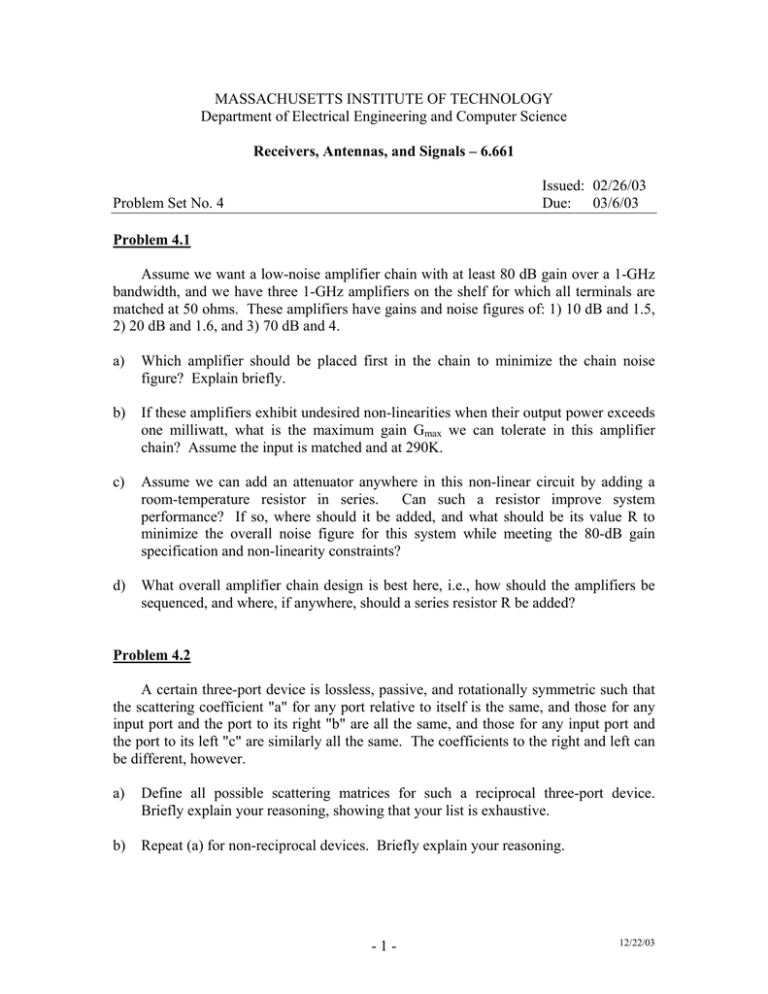MASSACHUSETTS INSTITUTE OF TECHNOLOGY Department of Electrical Engineering and Computer Science Issued:
advertisement

MASSACHUSETTS INSTITUTE OF TECHNOLOGY Department of Electrical Engineering and Computer Science Receivers, Antennas, and Signals – 6.661 Issued: 02/26/03 Due: 03/6/03 Problem Set No. 4 Problem 4.1 Assume we want a low-noise amplifier chain with at least 80 dB gain over a 1-GHz bandwidth, and we have three 1-GHz amplifiers on the shelf for which all terminals are matched at 50 ohms. These amplifiers have gains and noise figures of: 1) 10 dB and 1.5, 2) 20 dB and 1.6, and 3) 70 dB and 4. a) Which amplifier should be placed first in the chain to minimize the chain noise figure? Explain briefly. b) If these amplifiers exhibit undesired non-linearities when their output power exceeds one milliwatt, what is the maximum gain Gmax we can tolerate in this amplifier chain? Assume the input is matched and at 290K. c) Assume we can add an attenuator anywhere in this non-linear circuit by adding a room-temperature resistor in series. Can such a resistor improve system performance? If so, where should it be added, and what should be its value R to minimize the overall noise figure for this system while meeting the 80-dB gain specification and non-linearity constraints? d) What overall amplifier chain design is best here, i.e., how should the amplifiers be sequenced, and where, if anywhere, should a series resistor R be added? Problem 4.2 A certain three-port device is lossless, passive, and rotationally symmetric such that the scattering coefficient "a" for any port relative to itself is the same, and those for any input port and the port to its right "b" are all the same, and those for any input port and the port to its left "c" are similarly all the same. The coefficients to the right and left can be different, however. a) Define all possible scattering matrices for such a reciprocal three-port device. Briefly explain your reasoning, showing that your list is exhaustive. b) Repeat (a) for non-reciprocal devices. Briefly explain your reasoning. -1- 12/22/03 Problem 4.3 Consider the following double-conversion superheterodyne receiver: LC1 × TA f1 ~ LC2 × tr1, B1 G1, F1 f2 Local oscillators B2 = 12 MHz i.f. passbands 0 8 20 tr2, B2 G2, F2 ~ B1 = 50 MHz 50 f2 = 75 100 f (MHz) f1 a) This receiver employs no image rejection. Sketch the input spectral response function that shows to what input frequencies the output is responsive. b) What is the single-sideband (SSB) noise figure FSSB for the first stage of this receiver? c) What is the SSB noise figure for the combined receiver? Note that it is a little worse than it might otherwise be because the unused sideband input into the second mixer is not at 290K, but something greater that must be reflected in the answer. -2- 12/22/03 Problem 4.4 Figures 2.3-20 and 2.3-21 are reproduced (amended) below. i,vout vd i vin + - vout i.f. signal in time RL vin = vLO + vsig t 0 i.f. at beat freq. = fi.f. signal and local oscillator in phase out of phase vd LPF ⇒ local osc. alone t a) What happens to the output signal and the local oscillator noise when both diodes in this circuit are reversed? b) What happens to the output signal and the local oscillator noise when the local oscillator and signal are swapped and put in the others' port? Should the diodes be changed to make this configuration work and, if so, how? - 3 - signal output (a) Configuration before any swap L.O. 12/22/03











